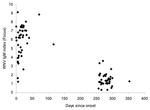
|
 |
Letter
West Nile Virus Detection
and Commercial Assays
Peter A.G. Tilley,* Gail A. Zachary,† Roberta Walle,* and Paul F. Schnee†
Gail A. Zachary,† Roberta Walle,* and Paul F. Schnee†
*Provincial Laboratory for Public Health, Calgary, Alberta, Canada; and
†Palliser Health Region, Medicine Hat, Alberta, Canada
Suggested
citation for this article
To the Editor: Roehrig and colleagues described the long-term
persistence of immunoglobulin (Ig) M antibody in patients with West Nile
virus (WNV) infection, as tested using an in-house Centers for Disease
Control and Prevention (CDC) enzyme immunoassay (EIA) (1).
This result suggests that interpreting WNV IgM results in subsequent years
would be difficult. With the commercial availability and widespread use
of US Food and Drug Administration–approved WNV IgM tests, we were concerned
that this phenomenon might also occur with new tests. Thus in 2004, we
initiated a follow-up study of patients infected during the inaugural
(2003) WNV season in Alberta, Canada.
Fifty patients who were WNV IgM positive by 2 commercial IgM kits (West
Nile virus capture EIAs, Focus Technologies, Cypress, CA, USA, and Panbio,
Windsor, Queensland, Australia) during the fall of 2003 were contacted.
Sera were recollected and tested for IgM and IgG antibodies to WNV with
current kits from these 2 companies. Sera were also tested for hemagglutination-inhibiting
(HI) antibodies to WNV (2).
|
Figure |
|
|
 |
|
|
Click to view
enlarged image
Figure. West Nile virus (WNV) immunoglobulin
(Ig)M index values in serum specimens from 38 WNV case-patients
detected in the fall of 2003...
|
|
Of 39 serum samples from 38 patients, 28 were positive, 5 were indeterminate,
and 6 were negative with the Focus IgM kit. Twenty-one were positive,
3 were indeterminate, and 14 were negative with the Panbio IgM kit. All
had WNV IgG antibodies detected by Focus and Panbio IgG kits. We detected
HI antibodies to WNV in all patients, and titers in 12 were ≥320. The
time course for IgM index values for the Focus IgM kit used in 2003 and
2004 is shown in the Figure.
These data show that when tests are conducted with newly available kits,
as with the CDC in-house test, IgM antibody to WNV persists for ≥8
months in most patients. A single high HI titer is not helpful in identifying
recent infection. In addition, the IgM test cannot differentiate between
recent and past infections. Interpreting a positive IgM result in WNV-endemic
areas will be complex because a positive WNV IgM result could indicate
a current acute infection or a previous WNV infection even in a person
with a different acute illness.
Acknowledgments
We thank M. O'Connor
and the staff of the Medicine Hat Regional Hospital laboratory for assistance
with specimen collection and transport.
This work was supported
by Alberta Health and Wellness, Calgary, Alberta, Canada.
References
- Roehrig JT, Nash D, Maldin B, Labowitz A, Martin DA,
Lanciotti RS, et al. Persistence
of virus-reactive serum immunoglobulin M antibody in confirmed West
Nile virus encephalitis cases. Emerg Infect Dis. 2003;9:376–9.
- Beaty BJ, Calisher CH, Shope RE. Arboviruses. In: Schmidt NJ, Emmons
RW, editors. Diagnostic procedures for viral, rickettsial, and chlamydial
infections. 6th ed. Washington: American Public Health Association,
1989; p.797–856.
Suggested citation
for this article:
Tilley PAG, Zachary
GA, Walle T, Schnee PF. West Nile virus detection and commercial assays
[letter]. Emerg Infect Dis [serial on the Internet]. 2005 Jul [date
cited]. Available from http://www.cdc.gov/ncidod/EID/vol11no07/04-1149.htm
|
